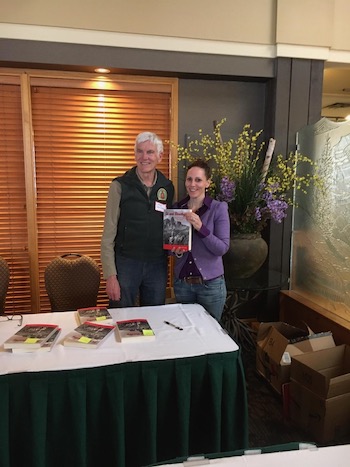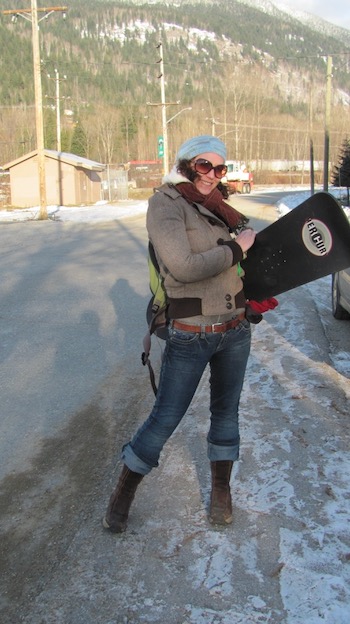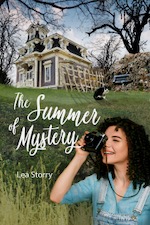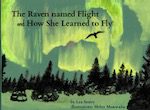by Lea Storry
The story I often tell about becoming a writer is a true tale.
I just can’t escape my last name: Storry. As a child I was teased and asked to “tell a story” or I was simply called “Storrybook.” However, I wanted to be an astronaut or a pilot.
Then, it all changed for me in Grade Four at Gaspereau Elementary School in Nova Scotia.

When I Knew I Was Going to be a Journalist
Here, my school day started with a discussion about current events. I always brought in a headline, thanks to my mother who listened to the local radio station.
I got hooked telling stories from the news.
That same year, my class did a newspaper week where we cut stories out of the paper as well as created our own newspaper. We interviewed people and wrote articles and I loved it so much.
That’s when I knew I was going to be a journalist. From that young age, everything I did, was in my quest to become a reporter.
Why Journalists Need an All-Around Education
After graduating from Grade 12, I went to Acadia University in Wolfville, Nova Scotia. I didn’t go straight into journalism school.
When I was in high school in the early 90s, my parents had attended an open house event for CBC Nova Scotia. One of the news anchors at the time, Norma Lee MacLeod, was there and my parents asked her for some advice to pass along to a budding reporter.
Norma Lee told them that I should first get an all-round education before going to journalism school. That was not what I wanted to do.
My dream was to jump right into the news world. I wanted to become a foreign correspondent who had a pilot’s license so I could fly myself in and out of troubled areas. However, I listened to Norma Lee and I went to Acadia for four years. There, I doubled majored in history and political science and graduated with a Bachelor of Arts (BA) in 1995.
With my BA out of the way, I looked at journalism schools in North America. Ryerson University (then Ryerson Polytechnic University) had the best program and was lauded across Canada. I applied to Ryerson’s highly competitive Journalism for Graduates program and got in. I went off to Toronto, Ontario for two years to learn how to be a journalist in three different formats – newspaper, television/radio and magazine.
I found I liked newspaper writing because the medium allowed for the best story to be told. Television and radio had time limits and magazines wanted too many words. Newspapers were the perfect length. Writing articles let me structure the news as a story.
I had to be creative too, not with the facts but how I moved the article along—from hooking readers on the first line, to ending on a fair and solid note.

My Chance to Become a Foreign Correspondent
When I graduated from Ryerson in 1997, there was an economic recession. I couldn’t find a job in the journalism field.
After a few months in retail, I found a job teaching English in South Korea. This was my chance to become a “foreign correspondent” albeit, on my own.
I wrote a bi-weekly column for my local paper, The Advertiser, in Nova Scotia. This was pre-portable laptops so I handwrote my stories and mailed them to Canada. I kept in touch with the editor over email that I accessed at internet cafes around Korea.
Some of my readers in Nova Scotia sent me letters and asked questions about my overseas adventures such as trying to read signs in Korean. I enjoyed answering my readers’ queries and was happy to share my experiences.
I continued with the column when I moved to The Gambia, West Africa, the next year. I was finally working as a reporter at a human rights organization.
Why I Started My Own Writing Business
Years later, I came to a point where I had followed the newspaper jobs as far as I could go.
In Calgary, I was in a serious relationship and I didn’t want to leave the city for work. So I decided to make my own. That was when I started my writing, editing and publishing business with a focus on memoirs.
My businesses, Our Family Lines and Our Corporate History, launched in 2011. Our Family Lines collects personal stories and Our Corporate History records company stories.
My Journalism Background Gave Me the Skills I Needed to Start My Own Business
I’ve always been interested in peoples’ stories, especially my own family’s anecdotes. Ever since I was young, I wanted to hear about how my mother and father met or what my grandparents did when they were little. It was fascinating to think of my Scottish grandmother as a young girl sitting on a train in Scotland on her way to a new life in Canada. The train went past her family farm and when she looked out of the train car window, she glimpsed her favourite dog sitting in the driveway. Waiting for her to come home.
My journalism background gave me all the skills I needed to start my business. I use my interviewing know-how, editing and layout abilities to take a memoir project from the start, getting your memories, to the finish, publishing the book.
I’ve told stories about a family who escaped Poland from under the Iron Curtain in the 80s. I’ve also told the story of a visionary surgeon who fled Iraq for Canada after his life was endangered by Saddam Hussein’s regime and the war with the U.S.
Not all the stories I’ve collected are as heart-stopping but they are just as compelling. Remembering the quiet moments such as a grandmother’s warm hug are just as important.
We all have stories that no one else can tell. Whether it is how you built a prosperous pizza restaurant or how you came here from another country—our life experiences and lessons deserve to be told.

We All Have Stories Worth Handing Down
I use my own family stories as memoir writing examples on my weekly blog. I interviewed my two grandmothers years before I started my business and I’m so happy I did. They’ve both died and it’s nice to have their stories.
I’ve been interviewing my parents too but day-to-day life sometimes gets in the way. Plus, it’s work! Some days, I simply want to listen to my parents talk about how they met or the silly things my sisters and I did growing up.
When we’re with family, most of us tell stories. Ancestry websites and shows digging into people’s roots are only increasing in popularity.
I also think it’s important to capture history in not just factual form but in story form too. I think about all the veterans in the First, Second and the Korean wars and how many of their stories have been lost. It doesn’t just have to be experiences during major events. Our lives are moving so quickly today, most of us are tied to our phones. We’re always looking forward to what we’re going to post online next. We’re not taking the time to look back and reflect.
I have worked with clients all over the globe as well as Alberta. It’s cliché to say but we all have stories that are worth being handed down.
Future generations can learn from our lives. We can show them what life was like when you had to get up to change the channel on the television or airplane food was free.
Those of you reading this are likely writers, too. I like to give those of you who want to put your story down in your own words, the tools to do that. I do memoir writing coaching, teach writing workshops, edit and indie publish other writers’ work.

I’m Not Sure Why Indie Publishing Gets a Bad Rap
Indie publishing used to be looked down upon but it’s becoming more and more acceptable. I’m not sure why indie publishing gets a bad rap when visual artists can display their paintings in cafés and sell their art. Anyone with a guitar can self-record an album to be downloaded off their website. However, if a writer deigns to publish their own work, somehow it must be second-rate.
No. Not the case.
Being published by a publisher is getting harder and harder to do. Once you find an imprint to send your query letter to, you then have to wait months and months to hear if the company wants your book. Even today, much of the marketing and promotion is left in the author’s lap. Long gone are the days where advertising and book tours are set up and paid for by publishers. Writers are in charge of their own endorsements.
Indie publishing means doing the promotion and marketing yourself but it cuts out the wait time of seeing your books in print. To some writers, that’s important. Their stories might be time-sensitive, such as coinciding with a personal anniversary, holiday or milestone.
For a couple of my clients, their stories have been in their heads for so long that they can’t rest until their experiences are in black and white—the sooner, the better.
How I Find Clients for My Writing Business
Networking is my go-to for finding clients.
Pre-Covid19, meeting people at events was the best way to talk to them and describe what I do. I belong to the Edmonton Chamber of Commerce and other organizations, which run networking events.
As a writing coach and memoir instructor, I also gain clients from these opportunities. I have edited and published memoirs by people I’ve taught at seniors’ or continuing education centres. Word of mouth from previous patrons helps bring business my way, too.
My website and social media does a bit of sales funneling for me. Otherwise, I don’t advertise or run any online promotions. I let my writing speak for me.

The Key to Working with People and Their Stories
Working with different people from different walks of life, who have different expectations is something I have to navigate with each client.
I always build an outline with them that shows how we’re going to get from A to B to Z. I put expectations and deadlines in a contract, too.
However, some clients will always push boundaries.
They’ll want a discount or more editing for free or additions that aren’t in the contract. It’s hard for me to put my foot down because it’s my reputation on the line. That being said, my clients walk away with a smile when their book is finished.
One Calgary senior I was working with than was particularly gruff and unfriendly while we worked on his story. He had carried some trauma from his upbringing and youth for over 80 years. When I handed him his book, he broke out in the hugest of grins. He admitted to me then that he never thought he’d see the day his words were in print. He thought I would walk away, leaving him with blank pages.
Half of my clients opt to keep their family stories private and just for their loved ones. Others want to tell their stories and share them with the public. Either way, I’m glad to have helped them finish their books.
What Helps Me to Sell Books
I am a published writer of non-fiction and fiction. I have written fiction books for children as well as short stories and poetry. I’m currently working on a screenplay.
I’ve indie published a couple of my books and have been promoting and marketing them on my own. It’s tough being a self-promoter and I admit, I’m not great at it. I’m good at talking up someone else’s book or product, just not my own.
Influencers and reviews are what helps to sell books and Oprah’s not following me on Twitter. I have to constantly push my “products.” I post to my social media regularly as well as put my books in bookstores. I’ve started attending farmers’ markets to sell my books and while it puts my stories in front of people, it hasn’t turned a profit.
I was part of a small group of three authors who attended holiday markets this past November and December. There was a considerable amount of work upfront including filling out applications as well as taking out extra insurance that the market asked for. Then there was the pre-set-up that included buying more books and items for the booth. Once at the market, I spent seven hours at my stall and sold a total of four books. Time also equals money and the market did not make a return.
Finding readers is hard. You can show art at a café or play a song while people are strolling by on the street to introduce them to your work. It’s tough to get people to stop at a booth and read a couple of paragraphs. Nevertheless, I was happy to chat about writing as most people who paused at the stall were also writers.
One new avenue I’m following to attract more readers is translating my illustrated children’s book, The Raven Named Flight and How She Learned How to Fly, into Japanese. My story is set in the Canadian north, where, as you’ve read, I lived for a few years.
Pre-pandemic, the Northwest Territories welcomed many tourists from all over the world, especially Japan. My English version of Flight is already in stores in Yellowknife and Enterprise and I’d like to feature Flight in Japanese too in 2022.
How I Fit Writing Into My Busy Life
What’s that saying about there never being enough time in a day? It’s true. There are times my creative writing has to take a backseat to my work writing during the week. Nevertheless, the weekends are for my characters. I get to dive into their worlds without any client emails, texts or phone calls to distract me.
Another way of balancing my business writing with my personal writing is that I have deadlines for both. As a journalist, I’m very deadline-driven. I hold myself accountable by writing them down in my day planner and my monthly online planner.
When I finish my work project at 3 in the afternoon, I have a couple of hours to work on my creative stuff. That could be writing a query letter, looking for publishers or reading my Alberta Writers’ Guild enewsletter.
I also work on more than one story at a time. I rotate my writing. I might work for 10 minutes on a short story and then 20 minutes on my screenplay. It’s a system that’s flexible and I can work on what I feel like. I don’t hold myself to a word count unless I’m writing with NanNoWriMo, a great way to write a book in a month.
Physical activity is a major part of my writing-life balance. I work out scenes and come up with different perspectives for all my writing when I get outside and run or bike or swim. It’s amazing what a short walk will do for your imagination. People strolling by are sometimes a boon for creativity whether it’s how they dress, how they move or what you just might hear them say.

I Make Working Out a Priority
Being active is another facet of my business. For me, physical and mental health are linked.
I make working out once a day a priority. I know I’ve said I could always use more time but going to the gym is worth an hour out of my day. It’s amazing how much garbage I sweep out of my mind when I’m only focusing on lifting weights.
Deadlines, scheduling and routines are other ways I’ve learned to keep my business on track. I have an old school paper day planner. That’s so I can scratch things off and scribble notes as the day goes along.
I also have an online monthly planner to give me a wider scope of my projects. I have a daily routine, too, starting with posting my social media, then reading the news, answering emails and then starting my main task. I am flexible though and my routine is not written in stone.
Tips for Starting Your Own Writing Business
Have a laptop and a phone? You can start a writing business. It’s that easy.
However, don’t forget about branding, marketing, accounting, finding clients, payments, privacy policies and so much more.
While I was setting up my business, I took a self-employment course at MNP in Calgary. At first, I found the weekly classes tedious—I wanted to run before I could walk. But I had to learn the minutia and inner workings of a business before launching a fully formed company. Before the course, I would have never thought about spreadsheets or GST.
Setting prices is tough, too. Some people don’t value writing as work. They think, “Oh, I write memos every day and it doesn’t take that long or a lot of effort.” They believe writers shouldn’t be paid for their skills, knowledge and experience. But we should all be paid what we’re worth.
Don’t undercut other writers by offering to write for free or nearly free. Charge fair prices. After 10 years in business, I’m still learning how to not back down when a prospective client says I’m too expensive. If I was a lawyer, you’d pay me his/her/their rate.
Another thing I do differently today, than when I first started my company, is I listen to my gut. We hardly ever listen to our instincts and we should.
If there are red flags with a prospective client, don’t talk yourself out of ignoring the warning signs. You can make all the excuses in the world for that person but bottom line – they’re going to cut into it. They’re going to take your time and not pay you for it. I’ve been there and despite my Spidey senses saying, “Stay away,” I took the job and it cost me professionally and personally from the time the woman wasted, to the headaches she caused me.
You don’t have to take the job if you think it’s going to lead nowhere. Sometimes that means you’ll have to fill your pocketbook some other way. I took gigs handing out face cream samples at Walmart for a couple of months. Once, the distributor forgot to send the samples to the store so I had to stand in the sample booth for eight hours in case anyone wanted to ask a question. No one did except a couple of people did tell me how sorry they felt for me. I replied that I was getting $21 an hour to stand in an empty booth. Easy money! Plus, it gave me fodder for more stories.
All our experiences are material to use in our writing. If we didn’t have lessons learned, we would be boring people. This is one Storry who can tell you to write your tales down. Publish them! Our stories give our past, a future.
* * *
 Lea Storry (yes, that’s her real last name) is a writer who owns a writing, editing and publishing business.
Lea Storry (yes, that’s her real last name) is a writer who owns a writing, editing and publishing business.
She can also fly a plane and throw a Frisbee but not at the same time.
Lea lives with her husband in Edmonton, Alberta, Canada.
For more information on Lea and her work, please see her website and connect with her on Facebook, Twitter, Instagram, YouTube, and Goodreads.
 The Summer of Mystery: A Katie Brunswick Whodunit
The Summer of Mystery: A Katie Brunswick Whodunit
Katie Brunswick is an eleven-year-old girl who lives with her parents and two younger sisters in a small Canadian town. This summer, she’s hanging out with her friends, an all-girl group who call themselves “The Posse.”
Katie is a competitive swimmer and her other favourite thing to do is read mysteries. Imagine her excitement when a whodunit turns up in her neighbourhood. Katie peeks through a dirty window in a deserted house and spies a body!
While she’s figuring out who was murdered and by whom, she tangles with some unsavoury characters. Meanwhile, she’s saving animals from climate change… and trying not to argue with her sisters.
Available at Amazon.
 The Raven Named Flight and How She Learned to Fly
The Raven Named Flight and How She Learned to Fly
Flight is a young raven born in Fort Smith in the Northwest Territories, Canada. She loves her family and hanging out in their comfy, cozy nest.
When it comes time for Flight to spread her wings, she first has to overcome her fear of flying.
Thanks to her parents, she finally leaves the nest.

